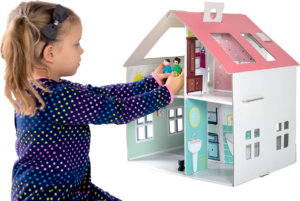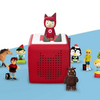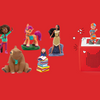How to support child development through games?

Types of games. How to support child development through play?
Games are inseparable element of human life. It appears very early, because in infancy. It is thanks to the fun that children will get to know the world around them in a pleasant way.
Play helps them to develop intellectually, emotionally, aesthetically, physically and spiritually. It teaches how to function in society and relationships with others. It creates character and attitude towards the world in a child. One would be tempted to say that he teaches life.
Play can not be treated as a filler of time. It should be creative to support the child at every stage of its development.
Games can be divided into several types that are very easy to observe during the child's development.
1. Manipulation
They teach control over their own body, appear at the earliest and rely on the manipulation of the object in various ways, watching, licking, sucking, translating from hand to hand, inserting and removing, rolling, etc. This type of fun is aimed at learning the properties of objects: shape, consistency or sound. The child manipulates objects by engaging visual, auditory, tactile observations and complex hand movements. This stage is the basis for later, more complicated games.
Examples of games:
Various invoices - fun for babies and toddlers.
Prepare pieces of materials with different textures, artificial fur, velvet, fine sandpaper, velcro, cardboard, bubble wrap, etc. Let the child touch various textures. Describe to your child every material saying that something is soft, rough, slippery, etc.
Unload and load - fun for children from the first year of life.
Children love to put in and take out items. They are fascinated by the fact that in one moment something can be full and empty in the next. A box with blocks is enough for this fun. Put the blocks on the floor and encourage the child to put them in the box, demonstrate to the child how to do it. Once the blocks are inside, show your child how to sprinkle them back. Talk to the child about the colors of the blocks.
Tear it! - fun for children from the first year of life.
Toddlers love to tear things. Make sure that the texture is varied, give your child an old newspaper, tissue paper, wax breakfast paper or paper towels. When the child is busy with the torn paper, talk to him about the feelings he is experiencing: "Is not this tissue paper soft?", "I think this breakfast paper is very slippery."
Remember that younger kids love to take everything into their mouths. Make sure your child does not eat paper.
What is it - fun for children from the age of two.
Encourage your child to play guessing. You will need a medium-sized carton with a lid. On the side wall, make a hole big enough for the child to put his hand inside, but not his head. Insert various items in succession, such as chalk, spoon, cup, comb, book. Let the child try to recognize the object only by touch and say what it is for.
2. Constructional
Stimulate the imagination. The constructional fun exercises the child's manual efficiency and awaken his creativity. They rely on building, creating something new. Naturally result from manipulation games. They differ, however, in the construction of a product that is the result of the child's actions. These types of games improve perceptual-motor development. They trigger ingenuity, implement to focus attention, teach observation. The most popular constructional toy are blocks. With their help, the child builds his own reality using unlimited imagination. Each design is unique and gives the child a lot of joy.
Examples of games:
Connecting elements - fun for older kids, from the second year of life.
Thicken out basic thick shapes (squares, triangles, etc.) or shapes of animals or objects (eg car) from thick colored cardboard. Using a hole punch that makes individual holes, make holes in cardboard boxes anywhere, taking care not to be too close to yourself or the edge. Pass the shoelace through the first hole and fasten it, tying it on the knot so that it does not run away from the child while playing. It's good that the color of the lace contrast with the pattern. Show your child how to thread the shoelace through the hole, and then let him train yourself. It is a great exercise for learning to thread and tie shoes. All you need is a suitable foot shape.
We make a cake - fun for older kids, from the second year of life.
Children love playing in the kitchen. Let your child help you prepare the cake. You will need: 1 glass of salt, 4 glasses of flour, 1 glass of warm water. In a bowl, mix salt with flour and add water. Knead the dough until it is soft. Encourage your child to knead the dough and create different shapes.
Such play develops precise motor skills. After finishing the game, put the dough in a sealed container.
Vase - fun for older kids, from the second year of life.
For this fun, prepare a small jar, plasticine, multicolor beads, buttons, shells, small plastic flowers, etc. Show your child. how to stick a jar with plasticine from the outside, when you're done, let the child decorate the vase according to your preferences. In such a vase you can store a flower made on a different occasion.
Chaplet- fun for older kids, from the second year of life.
Who of us did not make pasta noodles in childhood? It is an irreplaceable fun to train motor skills, and it gives a lot of joy when the child carries a handmade necklace around his neck.
You will need a string / shoelace and a tube-type pasta for this fun. Thread the first pasta and tie at the end of the knot. Show your child how to thread pasta on a thread. Observe the focus on the child's face.
All the best,
Amousewithahouse




